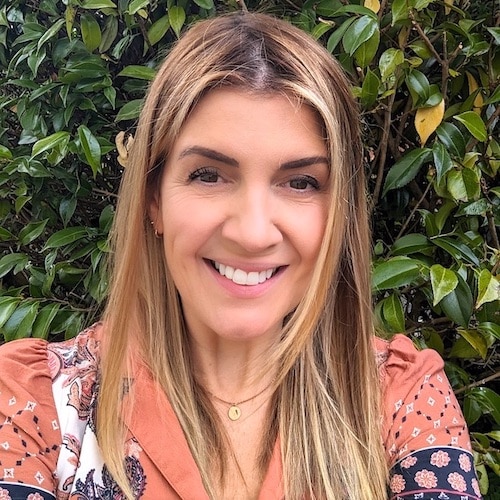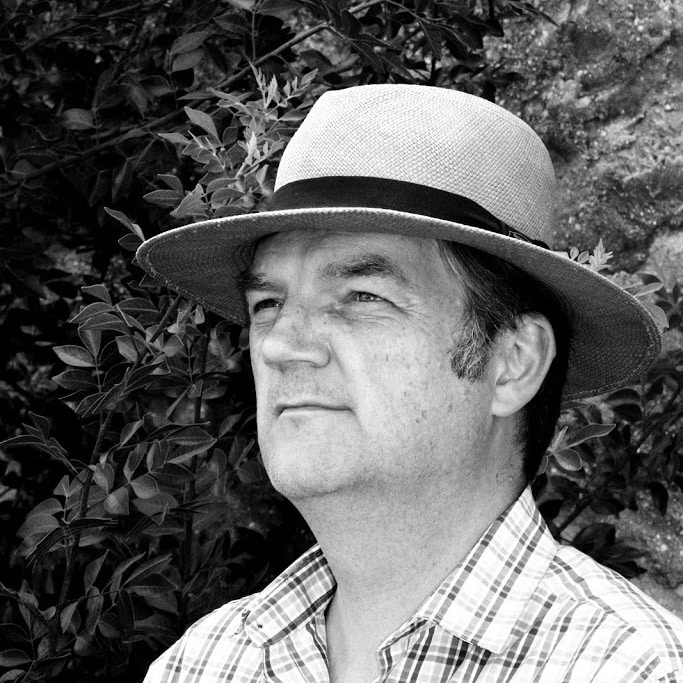This summer’s whirlwind of conference travel coincided with Taylor Swift’s massive Eras Tour, sparking a curious thought: could Swift’s influence be more pervasive than we realise, even in academic circles? With over 240 research publications and numerous studies citing her impact, Taylor Swift has become an unexpected muse for scholars across various fields. From the exploration of her lyrics in linguistics to discussions on her cultural influence, Swift’s presence in research is undeniable. In this post, I take a deep dive into the different “eras” of academic interest she’s inspired, tracing how her work has shaped conversations in everything from media studies to grant proposals. Welcome to the Research Eras Tour—let’s explore the scholarly side of Taylor Swift.
It’s been a Cruel Summer of conference travel with a surprising number of work trips that have inadvertently taken place either just before or just after one Ms Taylor Swift visited the very same city. As Wembley Stadium gears up to once again welcome Tay-Tay and tens of thousands of Swifties (including Me!) to one of five shows before she says So Long, London and wraps the European leg of her Eras Tour (for now – fingers crossed for a safe and sparkly do-over, Vienna), I couldn’t help but wonder whether Taylor wasn’t secretly attending those very same conferences herself. It’s no secret that her career and its impact have inspired a lot of research – most recently, the rise of ‘Swiftonomics’ or the influence that Taylor Swift has had on the economy has been a hot topic of discussion. What if she has influenced more than we realise, and has been attending these conferences to increase the impact of the research she has inspired? This Is Me Trying to discover which other eras of research Taylor has influenced.
Welcome to the Research Eras Tour. Are You …Ready For It?
Let’s start by searching for Taylor Swift in the Blank Space of the search bar in Dimensions and choosing Title and Abstract to reveal only the most relevant publications, patents, and other research outputs. Searching in full text gives over 5 thousand publications, but this would also include passing mentions of her, so I’m confining my search to mentions in the title and abstract only.
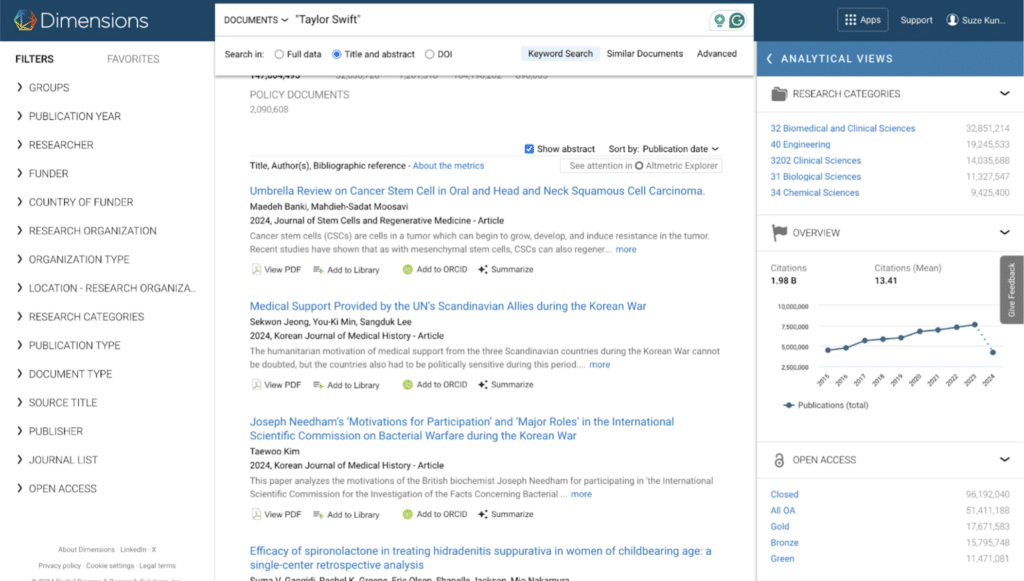
“It’s All Just F*cking Impossible”
Well, Dear Reader, I already know I’m going to love this little project, as the publication deemed to be “most relevant” has the Gorgeous title, ‘“It’s All Just F*cking Impossible:” The influence of Taylor Swift on fans’ body image, disordered eating, and rejection of diet culture’. The paper, which quotes Taylor Swift’s discussion about her own relationship with her body image in her Miss Americana documentary in its title, has an Altmetric score of 346 and counting, and the paper has been picked in 45 articles across 41 news outlets, as well as three blogs.
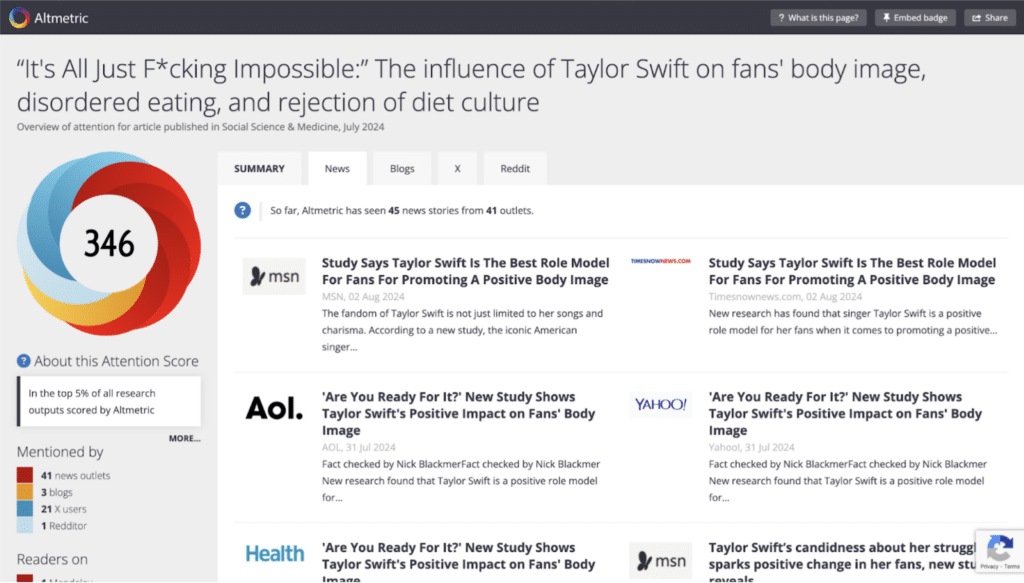
The article headings seem positive and suggest that Taylor Swift has indeed had a positive impact on how her fans perceive their own bodies in the face of society’s exhaustingly impossible and often unattainable expectations of how people should look, but it’s always best to read the source itself, so it’s Back to December – I mean, Dimensions – to learn more. The paper’s TL;DR summary as well as a quick read of the abstract both confirm that yes indeed, Taylor Swift and other celebrity role models can be positive influences on how people perceive themselves and the knock-on effect that can have on the related health issues people could be facing.
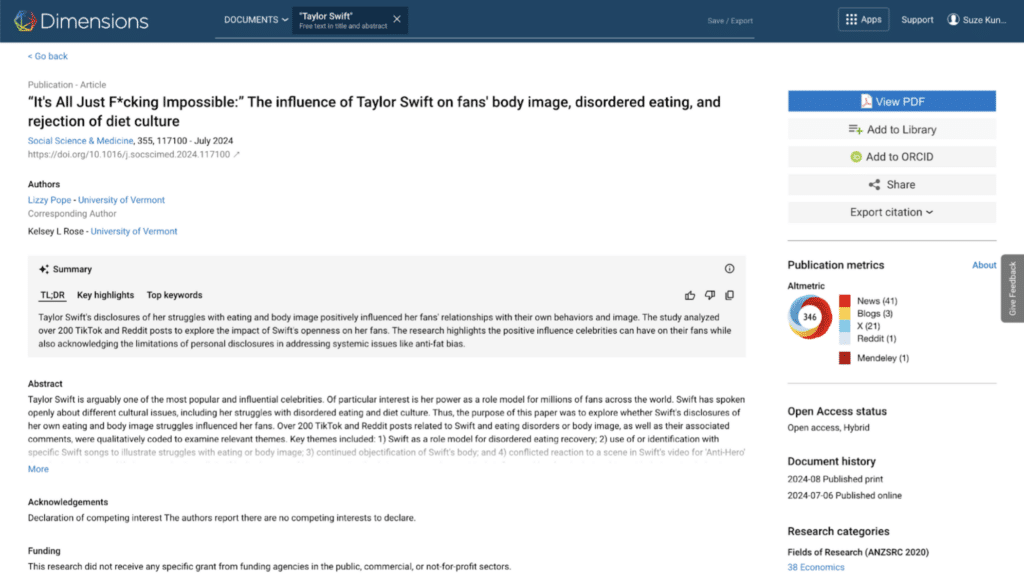
But back to the topic at hand. A quick glance at the top line of research outputs shows that, to date, 241 publications have “Taylor Swift” in the title or abstract, as well as 14 data sets, three grants, and one clinical trial. Not bad for someone whose debut album came out in 2006.
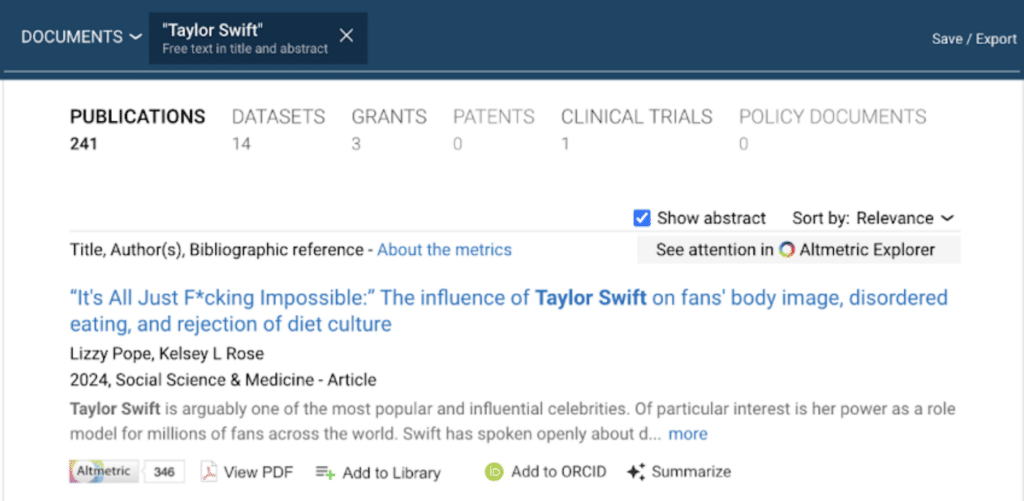
Long Story Short
So how has Taylor Swift impacted research? Let’s take a look, from 2006 until now. The graph below shows the total number of publications from 2006 to 2024. However no publications mentioned Taylor Swift at all until 2012, the year her Red album was released. There was a rise in interest in 2016, perhaps due to the lag of the impact generated after her much poppier 2014 album,1989, or in anticipation of 2017’s Reputation, arguably the best Taylor Swift album so far. I say arguably – I will argue that it is the best one because as eras go, that’s Mine.
Taking a look at the research themes and concepts, there seem to be five distinct clusters of language, lyrics, celebrity impact, and controversy, as well as one satellite group focusing on the works of Mark Twain, but what isn’t clear from this summary is how Everything Has Changed in terms of the volume of publications across different fields of research over time. To better understand Taylor Swift’s research eras, let’s take a look at the same information broken down by fields of research.
The graph below shows the five main fields of research of publications that mention Taylor Swift in either the title or abstract; Linguistics, Music, Communication and Media Studies, Creative Arts and Writing, and Language, Communication and Culture. As my teammate and friend Dr Hélène Draux pointed out, it is very nice to see other women artists featuring so prominently within these clusters. Although the overall trend is an increase in publication volume over time in almost all five fields, there are peaks and troughs that can be interrogated further. By isolating each field of research, we can discover more.
The Linguistics Era – 2019
Although publication volume increased after 2020, the Linguistics field of research could be said to have had an earlier peak in 2019. Looking at the rise in publications from 2016, aside from Language, Communications and Culture it was the only field of research that was increasing in its publication volume. Popular papers include one focused on a linguistic breakdown of the lyrics to the song Red, the contents of which have given me major flashbacks to GCSE English and my utter inadequacy in being able to reflect on the symbolism of any metaphor used in any piece of writing. Sorry, Mrs Sharpe. The scarf just seemed ‘scarfy’ to me…

The Communications And Media Studies Era – 2020
This field of research was partially responsible for the initial visibility of Taylor Swift-related research in the data, with its first publication back in 2012. Though there was an early peak in 2016, there were no publications related to this ‘era’ in 2018 or 2021 at all. However, between these two years, the number of publications peaked at five in 2020, cementing this year as The Communication and Media Studies Era. Trips right off your tongue, doesn’t it? Popular papers of this era focused on Taylor Swift’s forays into political alignment with the Democratic Party and her standing up for groups with less of a voice, perhaps catalysed in part by her 2019 album Lover featuring the hit song You Need To Calm Down and its perfect music video poking fun at the haters that continue to hate (hate, hate, hate, hate, hate), and of course the punchy one-line reminder that “shade never made anybody less gay”.
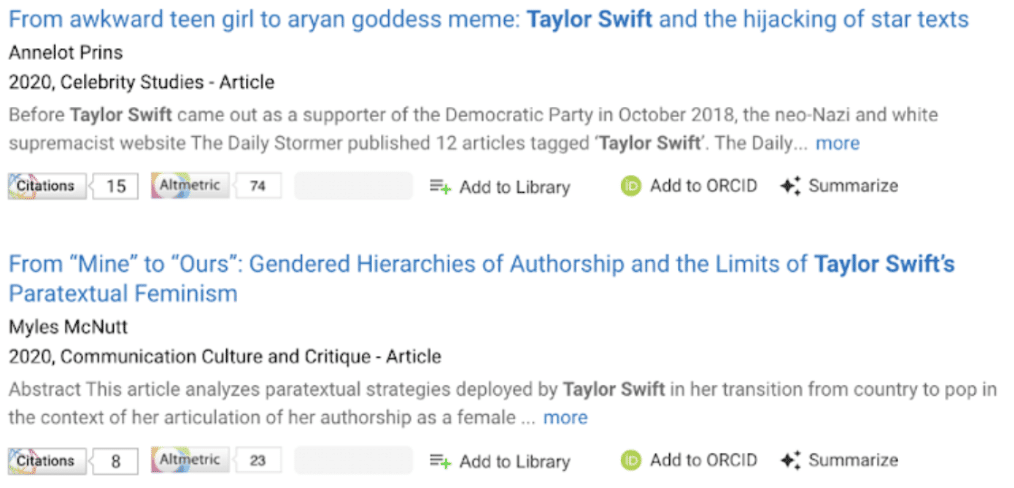
The Music Era – 2021
The discourse around Taylor Swift’s impact and influence on political and cultural advocacy continued into 2021, but this time in the slightly broader context of the role that music and musicians can play in nudging cultural behaviours. With another earlier but smaller peak in publications in this field of research 2016, and despite publications in this area continuing to increase over time, 2021 can be considered the era of music research, coming second only in volume to Creative Arts and Writing which has its own more dominant peak in research volume later down the line. Classic papers of the Music Era continue to focus on the Lover album with themes of allyship and inclusion but with hints of 2017’s Reputation creeping in with themes of re-evaluation and re-imagining.
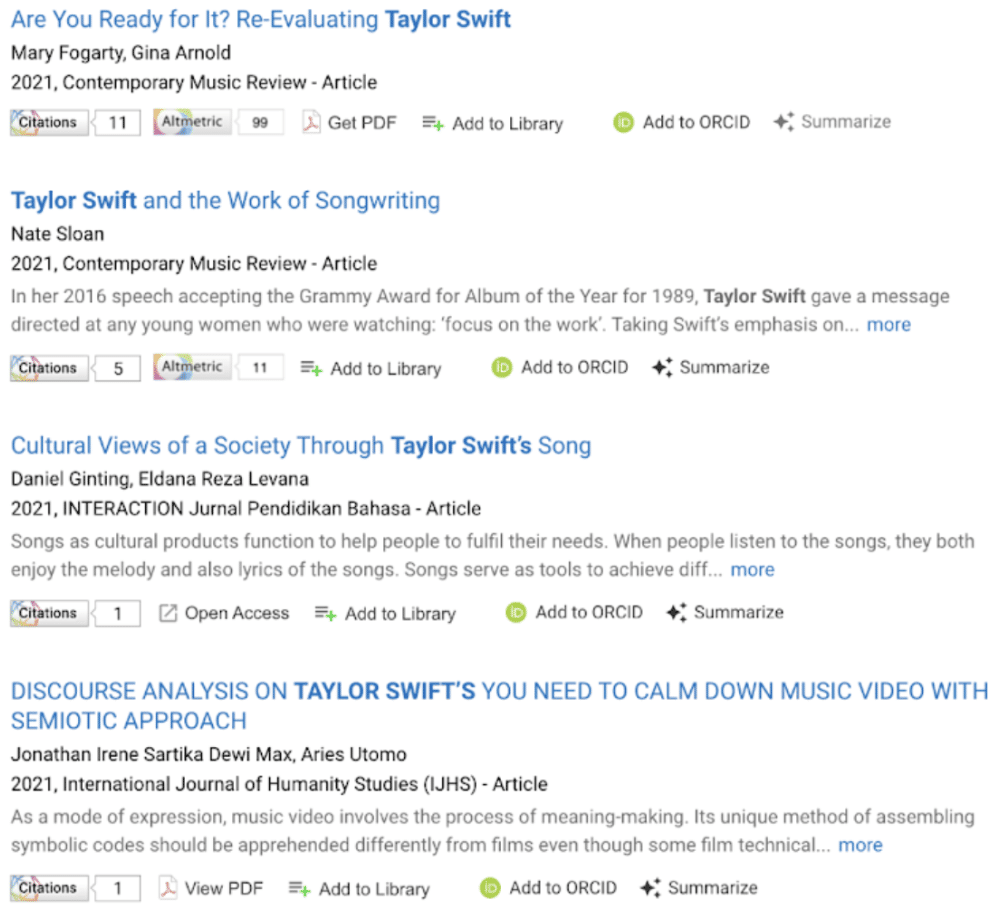
The Creative Arts And Writing Era – 2022
What did you do during the first COVID-19 lockdown of 2020? If you were anything like me, you hooked up your old SNES to your ‘big TV’, learned the art of cocktail making – or drinking in my case, and diligently attended your daily Yoga With Adriene sessions. If you were Taylor Swift, you casually wrote, recorded and released two albums. The impact of Folklore and Evermore is evident in 2022, as the Creative Arts and Writing Era took hold. Some of the big hitters of this era include papers on storytelling through songwriting, and how her folkier, stripped-back albums packed with nostalgia perfectly reflected the societal vibe of the early period of the COVID-19 pandemic.
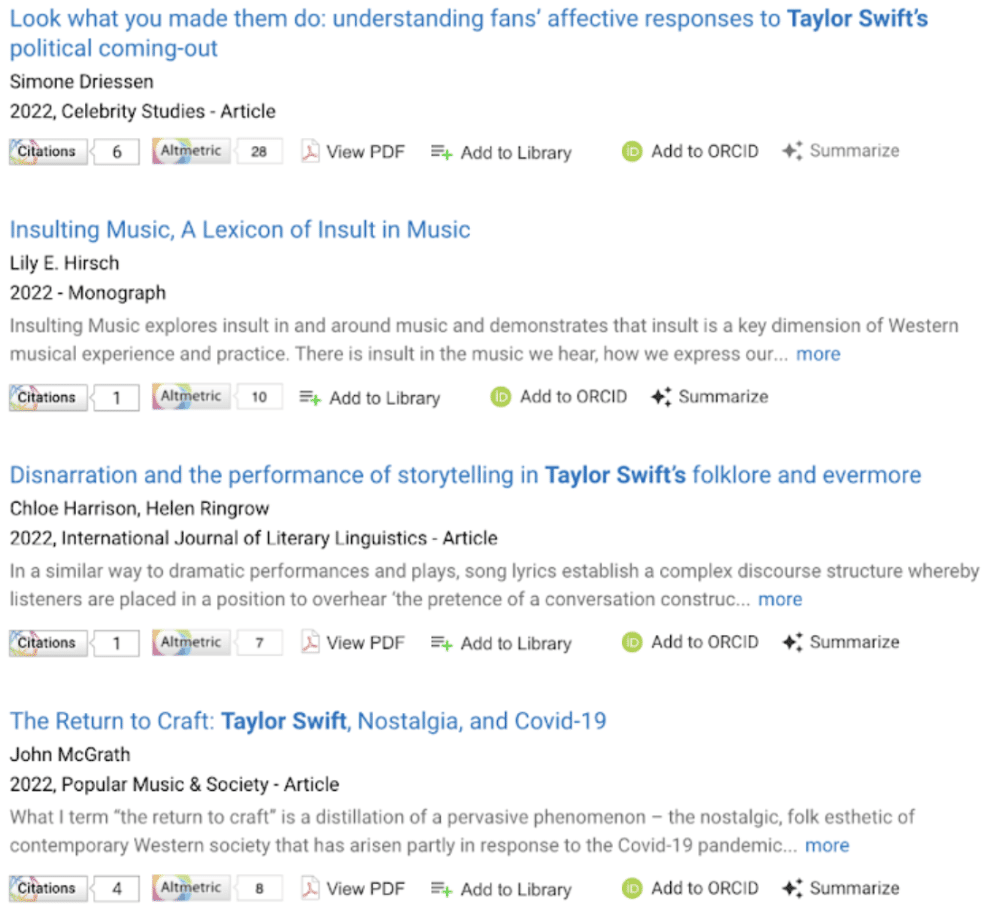
The Language, Communication And Culture Era – 2023
Very much our current research era and the one that presently dominates is the language, communication and culture era. With an early peak in 2019, it is the field of research that now not only has the most publications within it over time, but the largest increase in publication rate since 2021. Hits from this era include a paper on the metaphoric meaning of the songs on the Reputation album (TL;DR – love who you love deeply and unashamedly – see, Mrs Sharpe, I got there in the end!), a similar deep dive into the lyrics of the Evermore album, Taylor Swift’s influence on inclusion and acceptance of all genders and sexualities, and a screaming celebration of Taylor Swift’s Woman of the Decade speech that also asks the question, now what?
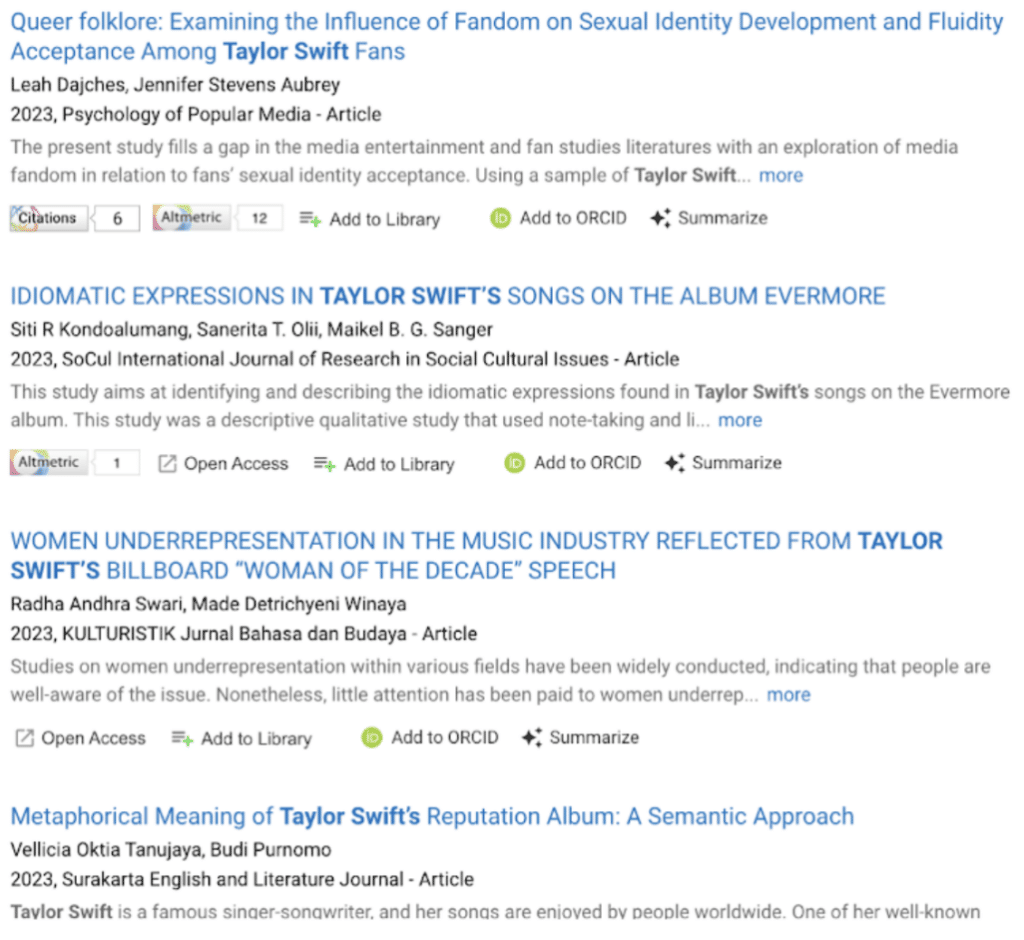
The Swiftonomics of Grant Funding
The world of grant writing seems to have cottoned onto the impact of Swiftonomics and how an association with this public figure can garner attention. I was thrilled to see a mention of her in a Wellcome Trust grant for the amazing outreach and engagement initiative, “I’m A Scientist, Get Me Out Of Here”, which I took part in as a baby-researcher back when I was writing up my PhD thesis. Given its themes of breaking down barriers to inclusion and showcasing a range of human faces from the research community, I can’t think of a better-aligned name-drop. Well done, IAS Crew – I like your Style! Will this be the focus of a future research era or just the next generation of Swifties? Time will tell.
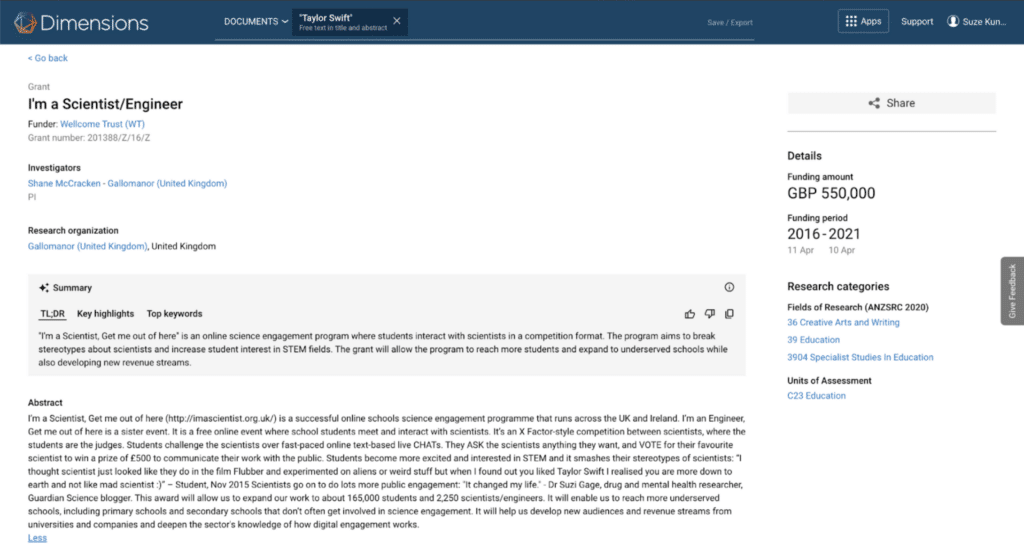
The Prophecy of Clinical Trials
The single clinical trial mentioning Taylor Swift focuses on a project hoping to determine whether there is any link between connecting with her music, and mental health. As anyone capable of repeatedly suffering through heartwrenching 10-minute vault versions knows All Too Well, Swift’s lyrics are deeply descriptive in their emotional analysis of everyday situations for people of all ages, not Only The Young. Could Taylor Swift’s song lyrics, and those of other musicians, help people (in Singapore in the case of this clinical trial) expand their emotional vocabulary and become more in tune with their thoughts and feelings, and know when to seek support? To speculate the outcomes of the trial would be Treacherous but the impact of Taylor Swift on research seems to be far from over just yet.
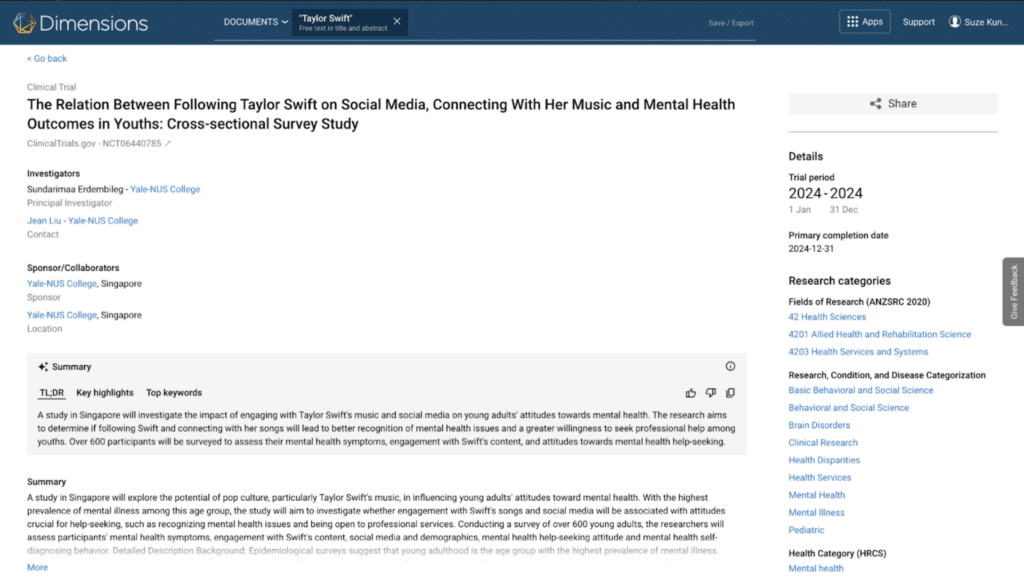
Paper Rings that Come Back Around
Let’s end on data sets, and specifically, Lizzy Pope’s data set on Figshare which actually takes us right back to a place where we can Begin Again, as this data informed the first paper mentioned in this article. “It’s All Just F*cking Impossible”, I hear you cry. Yes, and that’s also the title of the paper. It’s always great to see the data openly shared in the pre-publication stage, as the entire journey of that research can be followed from inception to impact, linked together by an Invisible String of metadata.
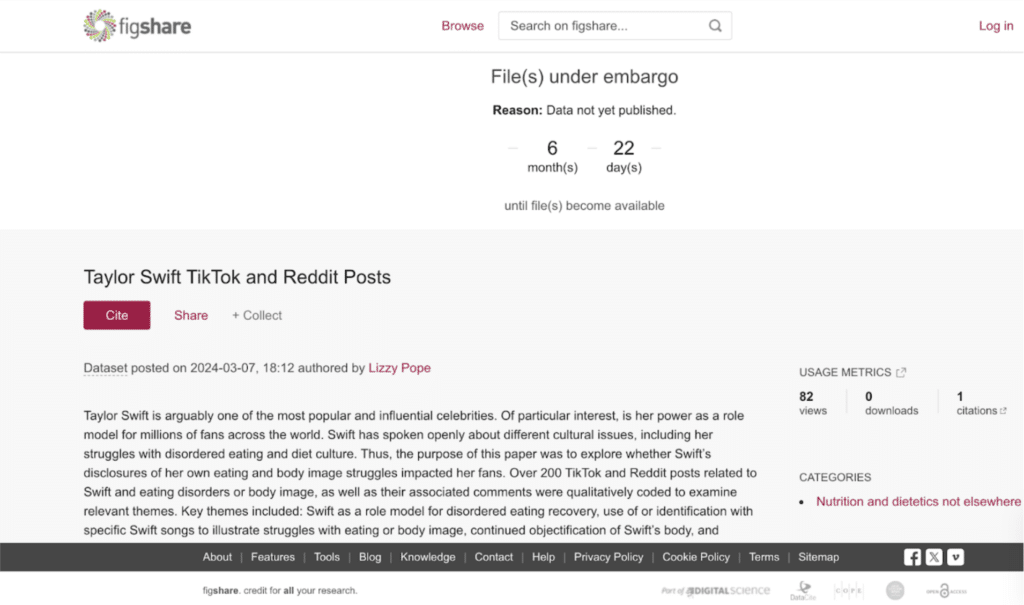
Epiphany
Never in my Wildest Dreams did I think that I’d be doing a Dimensions data dive about Taylor Swift, but who could miss such a great opportunity to celebrate a successful woman artist who has had an undeniable influence on research and popular culture? Don’t Blame Me for the terrible shoehorning of Taylor Swift song titles in this article. And a shout out to my teammates who threw down the gauntlet to see whether we could make this a thing – Look What You Made Me Do?! Perhaps this is the start of a brand-new series. Let us know your thoughts on this, and Speak Now if you’d like us to give your favourite thing the data nerdery treatment. With thanks to Taylor Swift for inspiring this article.
















